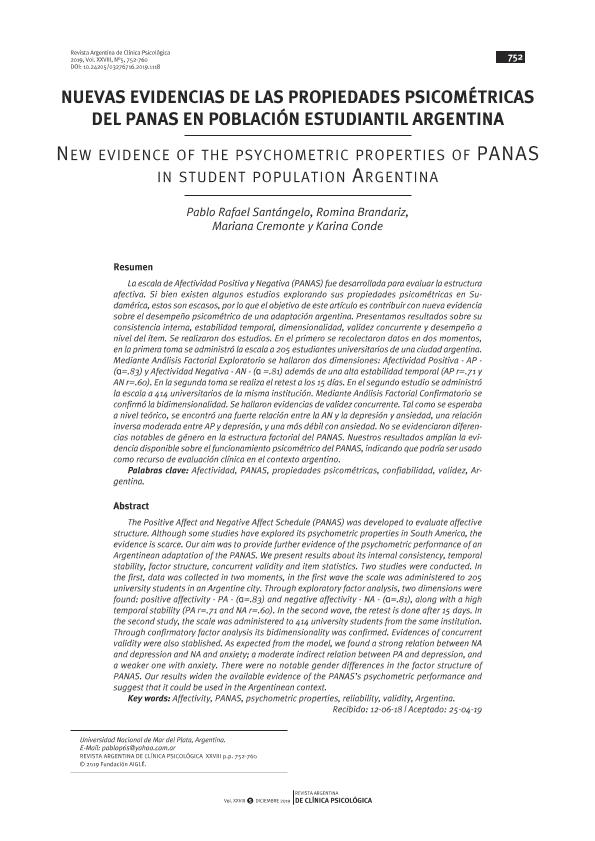Artículo
La escala de Afectividad Positiva y Negativa (PANAS) fue desarrollada para evaluar la estructura afectiva. Si bien existen algunos estudios explorando sus propiedades psicométricas en Sudamérica, estos son escasos, por lo que el objetivo de este artículo es contribuir con nueva evidencia sobre el desempeño psicométrico de una adaptación argentina. Presentamos resultados sobre su consistencia interna, estabilidad temporal, dimensionalidad, validez concurrente y desempeño a nivel del ítem. Se realizaron dos estudios. En el primero se recolectaron datos en dos momentos, en la primera toma se administró la escala a 205 estudiantes universitarios de una ciudad argentina. Mediante Análisis Factorial Exploratorio se hallaron dos dimensiones: Afectividad Positiva - AP - (α=.83) y Afectividad Negativa - AN - (α =.81) además de una alta estabilidad temporal (AP r=.71 y AN r=.60). En la segunda toma se realiza el retest a los 15 días. En el segundo estudio se administró la escala a 414 universitarios de la misma institución. Mediante Análisis Factorial Confirmatorio se confirmó la bidimensionalidad. Se hallaron evidencias de validez concurrente. Tal como se esperaba a nivel teórico, se encontró una fuerte relación entre la AN y la depresión y ansiedad, una relación inversa moderada entre AP y depresión, y una más débil con ansiedad. No se evidenciaron diferencias notables de género en la estructura factorial del PANAS. Nuestros resultados amplían la evidencia disponible sobre el funcionamiento psicométrico del PANAS, indicando que podría ser usado como recurso de evaluación clínica en el contexto argentino. The Positive Affect and Negative Affect Schedule (PANAS) was developed to evaluate affective structure. Although some studies have explored its psychometric properties in South America, the evidence is scarce. Our aim was to provide further evidence of the psychometric performance of an Argentinean adaptation of the PANAS. We present results about its internal consistency, temporal stability, factor structure, concurrent validity and item statistics. Two studies were conducted. In the first, data was collected in two moments, in the first wave the scale was administered to 205 university students in an Argentine city. Through exploratory factor analysis, two dimensions were found: positive affectivity - PA - (α=.83) and negative affectivity - NA - (α=.81), along with a high temporal stability (PA r=.71 and NA r=.60). In the second wave, the retest is done after 15 days. In the second study, the scale was administered to 414 university students from the same institution. Through confirmatory factor analysis its bidimensionality was confirmed. Evidences of concurrent validity were also stablished. As expected from the model, we found a strong relation between NA and depression and NA and anxiety; a moderate indirect relation between PA and depression, and a weaker one with anxiety. There were no notable gender differences in the factor structure of PANAS. Our results widen the available evidence of the PANAS’s psychometric performance and suggest that it could be used in the Argentinean context.
Nuevas evidencias de las propiedades psicométricas del panas en población estudiantil Argentina
Título:
New evidence of the psychometric properties of panas in student population Argentina
Fecha de publicación:
09/2019
Editorial:
Fundación Aiglé
Revista:
Revista Argentina de Clínica Psicológica
ISSN:
0327-6716
e-ISSN:
1851-7951
Idioma:
Español
Tipo de recurso:
Artículo publicado
Clasificación temática:
Resumen
Palabras clave:
AFECTIVIDAD
,
PANAS
,
PROPIEDADES PSICOMETRICAS
,
CONFIABILIDAD
,
VALIDEZ
,
ARGENTINA
Archivos asociados
Licencia
Identificadores
Colecciones
Articulos(IPSIBAT)
Articulos de INSTITUTO DE PSICOLOGIA BASICA, APLICADA Y TECNOLOGIA
Articulos de INSTITUTO DE PSICOLOGIA BASICA, APLICADA Y TECNOLOGIA
Citación
Santángelo, Pablo Rafael; Brandariz, Romina Antonela; Cremonte, Mariana; Conde, Karina Natalia; Nuevas evidencias de las propiedades psicométricas del panas en población estudiantil Argentina; Fundación Aiglé; Revista Argentina de Clínica Psicológica; 28; 5; 9-2019; 752-760
Compartir
Altmétricas




